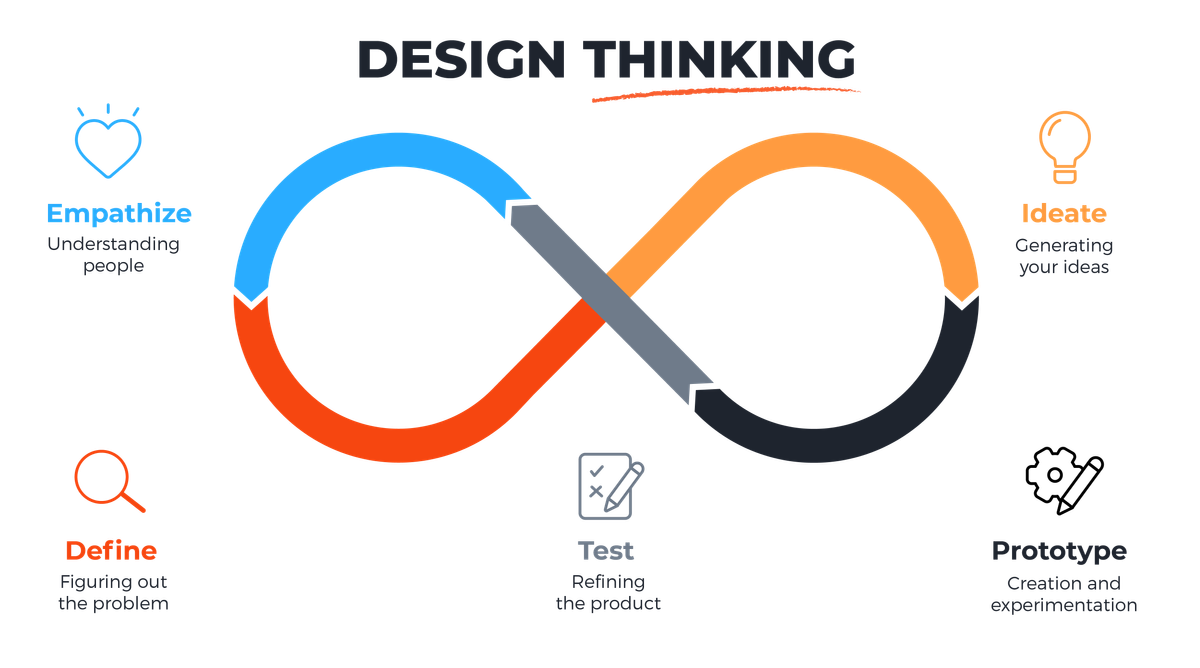Design Thinking
Design thinking is a problem-solving methodology that focuses on understanding user needs and creating innovative solutions. It is a human-centered approach that combines empathy, creativity and rationality to tackle complex problems.

Introduction
Design thinking is a problem-solving methodology that focuses on understanding user needs and creating innovative solutions. It is a human-centered approach that combines empathy, creativity and rationality to tackle complex problems. In this article, we will explore the key principles of design thinking, its uses and the steps involved in the process.
Key Principles of Design Thinking
Empathy: Design thinking starts with understanding the needs, motivations and challenges of the users. Empathy allows designers to gain insights into the user's perspective and uncover unmet needs.
Iterative Process: Design thinking is an iterative process that involves continuous feedback and refinement. Designers prototype and test their solutions multiple times to gather feedback and make improvements.
Collaboration: Design thinking encourages multidisciplinary collaboration. It brings together individuals with diverse backgrounds and expertise to generate a wide range of ideas and perspectives.
Visualisation: Visualisation techniques, such as sketches, diagrams and prototypes, are used to externalise ideas and make them tangible. Visualising ideas helps designers communicate and iterate on concepts effectively.
Bias Towards Action: Design thinking emphasises taking action and learning through experimentation. It encourages designers to prototype and test ideas early in the process to validate assumptions and gather real-world feedback.
Uses of Design Thinking
Design thinking can be applied to various domains and industries, including:
Product Design: Design thinking helps in creating user-centric products by understanding user needs, ideating innovative solutions and validating them through prototyping and testing.
Service Design: Design thinking is used to improve customer experiences by mapping out user journeys, identifying pain points and redesigning service processes.
Organisational Innovation: Design thinking can be applied to drive innovation within organisations. It helps in identifying new opportunities, fostering a culture of creativity and developing new business models.
Social Impact: Design thinking can be used to address complex social challenges. It enables designers to understand the needs of communities, co-create solutions with stakeholders and drive positive social change.
Design Thinking Process
The design thinking process typically consists of five key stages:
Empathise: In this stage, designers aim to understand the users' needs and challenges. They conduct interviews, observations and gather data to gain empathy and insights into the user's perspective.
Define: Designers analyse the data collected in the empathise stage to define the core problem or opportunity. They reframe the problem statement based on user insights and identify the key challenges to be addressed.
Ideate: In the ideation stage, designers generate a wide range of ideas to solve the defined problem. They encourage divergent thinking and use brainstorming techniques to explore multiple possibilities.
Prototype: In this stage, designers create low-fidelity prototypes to visualise and test their ideas. Prototypes can be sketches, wireframes, or physical models. The goal is to quickly iterate and gather feedback to refine the solution.
Test: Designers test the prototypes with users to gather feedback and insights. This feedback helps in refining the solution and making necessary iterations. The testing stage may involve usability testing, user feedback sessions, or A/B testing.
Conclusion
Design thinking is a powerful methodology that enables designers to create innovative and user-centric solutions. By focusing on empathy, collaboration and an iterative process, design thinking helps in tackling complex problems effectively. Its applications span across various domains, from product design to organisational innovation and social impact. By following the key principles and stages of design thinking, designers can unlock their creative potential and drive meaningful change.



